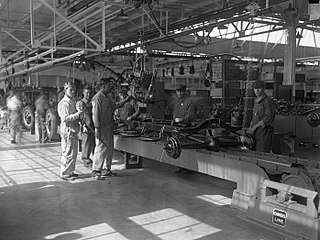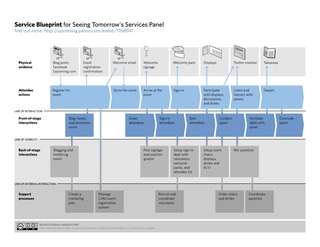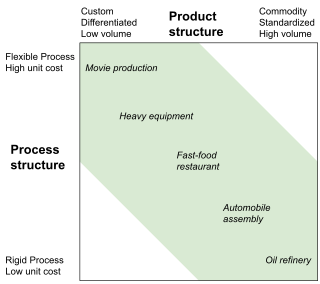Related Research Articles

Lean manufacturing is a method of manufacturing goods aimed primarily at reducing times within the production system as well as response times from suppliers and customers. It is closely related to another concept called just-in-time manufacturing. Just-in-time manufacturing tries to match production to demand by only supplying goods that have been ordered and focus on efficiency, productivity, and reduction of "wastes" for the producer and supplier of goods. Lean manufacturing adopts the just-in-time approach and additionally focuses on reducing cycle, flow, and throughput times by further eliminating activities that do not add any value for the customer. Lean manufacturing also involves people who work outside of the manufacturing process, such as in marketing and customer service.
Outsourcing is a business practice in which companies use external providers to carry out business processes, that would otherwise be handled internally. Outsourcing sometimes involves transferring employees and assets from one firm to another.
Job rotation is the lateral transfer of employees between jobs in an organization without a change in their hierarchical rank or salary grade. Rotated employees usually do not remain in these jobs permanently and may also not return to former jobs. The frequency and duration of intervals in a job rotation can vary widely from daily to periods of years. The practice serves several functions including staffing, employee motivation, managing employee fatigue, employee orientation and placement, and career development.

In microeconomics, diseconomies of scale are the cost disadvantages that economic actors accrue due to an increase in organizational size or in output, resulting in production of goods and services at increased per-unit costs. The concept of diseconomies of scale is the opposite of economies of scale. It occurs when economies of scale become dysfunctional for a firm. In business, diseconomies of scale are the features that lead to an increase in average costs as a business grows beyond a certain size.

Temporary work or temporary employment refers to an employment situation where the working arrangement is limited to a certain period of time-based on the needs of the employing organization. Temporary employees are sometimes called "contractual", "seasonal", "interim", "casual staff", "outsourcing", and "freelance"; or the words may be shortened to "temps". In some instances, temporary, highly skilled professionals refer to themselves as consultants. Increasingly, executive-level positions are also filled with interim executives or fractional executives.
Job enrichment is a method of motivating employees where a job is designed to have interesting and challenging tasks which can require more skill and can increase pay.
Agile Manufacturing is a modern production approach that enables companies to respond swiftly and flexibly to market changes while maintaining quality and cost control. This methodology is designed to create systems that can adapt dynamically to changing customer demands and external factors such as market trends or supply chain disruptions.

Operations management is concerned with designing and controlling the production of goods and services, ensuring that businesses are efficient in using resources to meet customer requirements.
Lean thinking is a management framework made up of a philosophy, practices and principles which aim to help practitioners improve efficiency and the quality of work. Lean thinking encourages whole organisation participation. The goal is to organise human activities to deliver more benefits to society and value to individuals while eliminating waste.
A contract manufacturer (CM) is a manufacturer that contracts with a firm for components or products. It is a form of outsourcing. A contract manufacturer performing packaging operations is called copacker or a contract packager. Brand name companies focus on product innovation, design and sales, while the manufacturing takes place in independent factories.
Competence is the set of demonstrable personal characteristics or KSAOs that enable job performance at a high level with consistency and minimal difficulty. Competency in human resources is an organizational criterion for excellence that encompasses the behaviors, experience, knowledge, skills, and abilities that enable employees to perform their roles effectively and reliably.
On-the-job training is an important topic of human resource management. It helps develop the career of the individual and the prosperous growth of the organization. On-the-job training is a form of training provided at the workplace. During the training, employees are familiarized with the working environment they will become part of. Employees also get a hands-on experience using machinery, equipment, tools, materials, etc. Part of on-the-job training is to face the challenges that occur during the performance of the job. An experienced employee or a manager are executing the role of the mentor who through written, or verbal instructions and demonstrations are passing on his/her knowledge and company-specific skills to the new employee. Executing the training on at the job location, rather than the classroom, creates a stress-free environment for the employees. On-the-job training is the most popular method of training not only in the United States but in most of the developed countries, such as the United Kingdom, Canada, Australia, etc. Its effectiveness is based on the use of existing workplace tools, machines, documents and equipment, and the knowledge of specialists who are working in this field. On-the-job training is easy to arrange and manage and it simplifies the process of adapting to the new workplace. On-the-job training is highly used for practical tasks. It is inexpensive, and it doesn't require special equipment that is normally used for a specific job. Upon satisfaction of completion of the training, the employer is expected to retain participants as regular employees.
Cellular manufacturing is a process of manufacturing which is a subsection of just-in-time manufacturing and lean manufacturing encompassing group technology. The goal of cellular manufacturing is to move as quickly as possible, make a wide variety of similar products, while making as little waste as possible. Cellular manufacturing involves the use of multiple "cells" in an assembly line fashion. Each of these cells is composed of one or multiple different machines which accomplish a certain task. The product moves from one cell to the next, each station completing part of the manufacturing process. Often the cells are arranged in a "U-shape" design because this allows for the overseer to move less and have the ability to more readily watch over the entire process. One of the biggest advantages of cellular manufacturing is the amount of flexibility that it has. Since most of the machines are automatic, simple changes can be made very rapidly. This allows for a variety of scaling for a product, minor changes to the overall design, and in extreme cases, entirely changing the overall design. These changes, although tedious, can be accomplished extremely quickly and precisely.
Quick response manufacturing (QRM) is an approach to manufacturing which emphasizes the beneficial effect of reducing internal and external lead times.
Lean IT is the extension of lean manufacturing and lean services principles to the development and management of information technology (IT) products and services. Its central concern, applied in the context of IT, is the elimination of waste, where waste is work that adds no value to a product or service.
Customer service training (CST) refers to teaching employees the knowledge, skills, and competencies required to increase customer satisfaction.

The service blueprint is an applied process chart which shows the service delivery process from the customer's perspective. The service blueprint is one of the most widely used tools to manage service operations, service design and service.
Operations management for services has the functional responsibility for producing the services of an organization and providing them directly to its customers. It specifically deals with decisions required by operations managers for simultaneous production and consumption of an intangible product. These decisions concern the process, people, information and the system that produces and delivers the service. It differs from operations management in general, since the processes of service organizations differ from those of manufacturing organizations.
The high performance organization (HPO) is a conceptual framework for organizations that leads to improved, sustainable organizational performance. It is an alternative model to the bureaucratic model known as Taylorism. There is not a clear definition of the high performance organization, but research shows that organizations that fit this model all hold a common set of characteristics. Chief among these is the ability to recognize the need to adapt to the surroundings that the organization operates in. High performance organizations can quickly and efficiently change their operating structure and practices to meet needs. These organizations focus on long term success while delivering on actionable short term goals. These organizations are flexible, customer focused, and able to work highly effectively in teams. The culture and management of these organizations support flatter hierarchies, teamwork, diversity, and adaptability to the environment which are all of paramount success to this type of organization. Compared to other organizations, high performance organizations spend much more time on continuously improving their core capabilities and invest in their workforce, leading to increased growth and performance. High performance organizations are sometimes labeled as high commitment organizations.

The Hayes-Wheelwright Matrix, also known as the product-process matrix, is a tool to analyze the fit between a chosen product positioning and manufacturing process.
References
- ↑ Nicholas, J. 2011. Lean Production for Competitive Advantage: A Comprehensive Guide to Lean Methodologies and Management Practices (Boca Raton, Fla.: CRC Press): 326.
- ↑ Hall. R.W. 1987. Attaining Manufacturing Excellence: Just in Time, Total Quality, Total People Involvement (Homewood, Ill., Dow Jones-Irwin): 106-7, 113-14, 127, 141-42.
- ↑ Schonberger, R. J. 1990. Building a Chain of Customers: Linking Business Functions to Create the World Class Company (New York: Free Press): 125-126.
- ↑ Suri, R. 1998. Quick Response Manufacturing: A Company-wide Approach to Reducing Lead Times (Portland, Ore.: Productivity, Inc.): 96-97, 122-123, 351, 477.
- ↑ Shuster, J.R., Zingheim, P.K. 1992. The New Pay: Linking Employee and Organizational Performance (New York: Lexington Books): 106-109.
- ↑ Sandras, W.A., Jr. 1989. Just-in-Time: Making It Happen--Unleashing the Power of Continuous Improvement (Essex Junction, Vt.: Oliver Wight Publications, Inc.): 228-229.
- ↑ Selko, A. 2008. "Automation helps Signicast stay ahead of the curve" Industry Week (July): 24.
- ↑ Schonberger, R.J. 2001. Let's Fix It! Overcoming the Crisis in Manufacturing (New York: Free Press): 20, 54, 251.